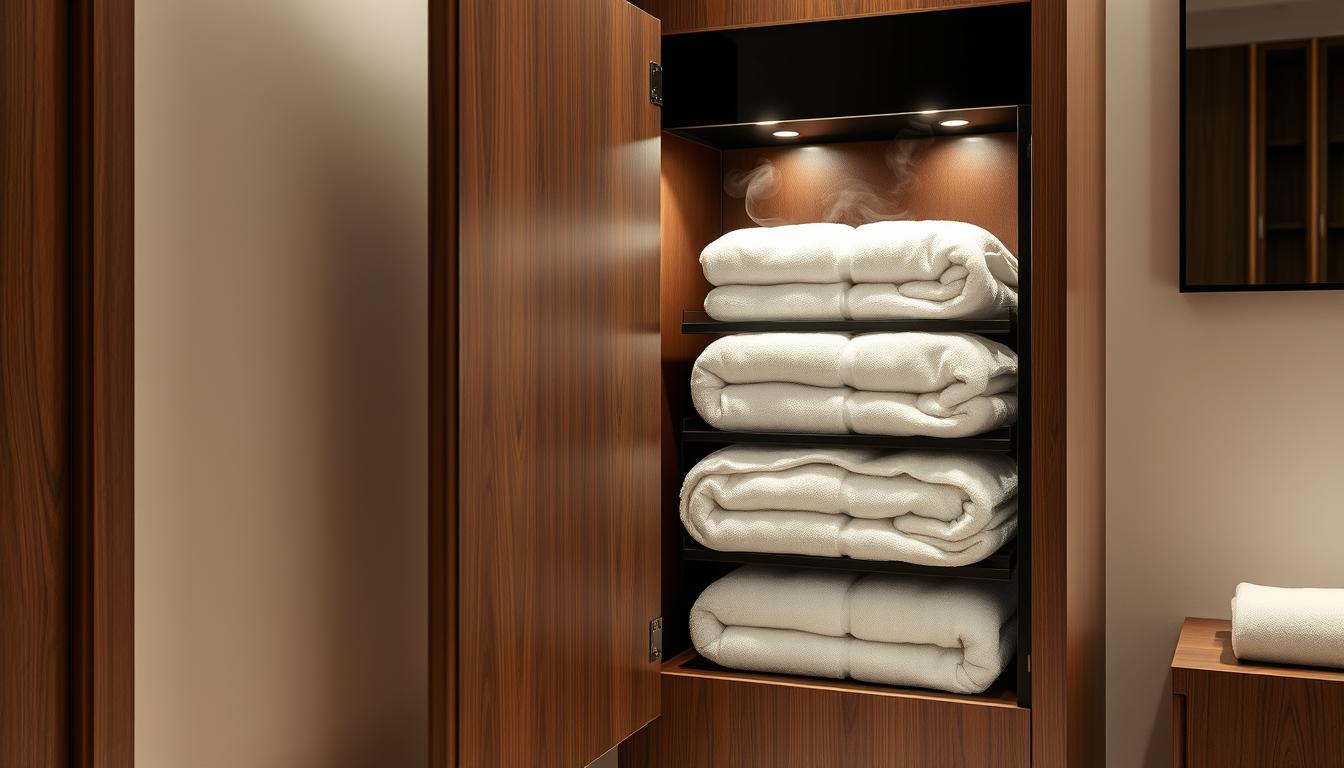Are you considering using a bidet for better hygiene? Bidets are gaining popularity as an alternative to traditional bottom-cleaning methods, such as toilet paper. They offer a more sanitary way to clean your lower region after using the toilet, effectively removing trace amounts of fecal matter with water. However, it’s important to understand how to use a bidet correctly to minimize the risk of bladder infections, especially for individuals with vaginas.
Proper bidet hygiene is crucial to prevent bacterial contamination. The water from the bidet should flow from front to back, similar to wiping from front to back with toilet paper. It’s important to keep in mind that bidets should only be used to clean the outside of the body, not the inside. Regular cleaning and maintenance of the bidet are essential to ensure a hygienic experience.
Key Takeaways:
- Using a bidet can improve personal hygiene and reduce the risk of bacterial contamination from fecal matter.
- Proper bidet use involves ensuring the water flows from front to back and avoiding the introduction of water into the vagina.
- Bidets offer additional benefits, such as gentler cleaning, increased comfort for individuals with certain conditions, and reduced environmental impact.
- To maintain bidet hygiene, follow the manufacturer’s instructions for cleaning and maintenance, avoiding direct contact between the bidet nozzle and your body.
- Practicing good handwashing hygiene is essential, even when using a bidet, to avoid the spread of germs.
The Benefits of Using a Bidet
Using a bidet offers several benefits besides improved hygiene. It can be gentler on the skin compared to wiping with toilet paper, which can cause chafing and small cuts. Bidets can also be more comfortable to use for individuals with hemorrhoids and fissures. In addition, using a bidet is eco-friendly, as it reduces the consumption of toilet paper and saves money in the long run. Furthermore, bidets can help prevent plunger incidents by reducing the amount of toilet paper that is flushed, minimizing the risk of clogging.
“Bidets are a great alternative to toilet paper and can offer some wonderful benefits to individuals who use them. They provide a gentle and thorough cleaning experience, promoting optimal hygiene. Plus, bidets can be a game-changer for those dealing with hemorrhoids, as they reduce irritation and discomfort. Additionally, bidets are environmentally friendly, helping to decrease the amount of toilet paper waste that ends up in landfills.”
Can Using a Bidet Cause a Bladder Infection?
The correct usage of a bidet is important to avoid the risk of bladder infections. For individuals with vaginas, the proximity of the urethra to the anus increases the risk of bacterial contamination. To prevent this, the water from the bidet should flow from front to back, similar to wiping from front to back with toilet paper. It is crucial to maintain the proper water pressure and angle of the water stream to avoid forcing water into the vagina. While bidets are generally considered safe and effective, it is essential to follow usage instructions and keep the bidet clean and properly maintained to minimize the risk of infections.
Safeguarding your bladder health is of utmost importance. By utilizing a bidet correctly, you can maintain proper hygiene without compromising your well-being. Bidets are designed to enhance cleanliness and reduce the risk of infection, but improper use can result in adverse outcomes. Following these simple guidelines is key to maintaining a healthy and infection-free bladder:
- Ensure that the water flow direction is from front to back to prevent the spread of bacteria towards the urethra.
- Be mindful of the water pressure and angle to avoid introducing water into the vagina, which may increase the risk of infection.
- Frequently clean and maintain the bidet to eliminate any potential bacterial buildup.
By practicing these bidet hygiene measures, you can confidently enjoy the benefits of a bidet while safeguarding your bladder health.

Remember, bidets are effective tools for maintaining personal hygiene, but proper usage is crucial to prevent bladder infections. By following the recommended guidelines and incorporating bidets as part of your daily routine, you can enhance cleanliness and reduce the risk of urinary tract infections.
Bidets and UTIs
Urinary tract infections (UTIs) are a common and bothersome health issue, affecting millions of people every year. While bidets are not a direct cause of UTIs, they can play a significant role in preventing these infections and promoting urinary health.
When using a bidet, it’s crucial to ensure proper hygiene practices. The bidet should be used with a front-to-back water flow, mimicking the motion of wiping from front to back with toilet paper. This helps to avoid the introduction of bacteria into the urinary tract, reducing the risk of UTIs.
Using a bidet also provides thorough cleaning after using the toilet, which is essential for maintaining good urinary health. Bidets effectively remove residual fecal matter that may remain after wiping, ensuring a higher level of cleanliness and reducing the chances of bacterial growth.
By incorporating bidets into your bathroom routine and following proper bidet usage, you can minimize the occurrence of UTIs and promote better urinary health overall. Remember to always practice good hygiene habits, such as wiping from front to back or using a bidet correctly, to maintain optimal urogenital health.
Take a look at the table below for a quick summary of the benefits of bidets for urinary health:
| Benefits of Bidets for Urinary Health |
|---|
| Reduces the risk of urinary tract infections (UTIs) |
| Ensures thorough cleaning after toilet use |
| Promotes better hygiene and cleanliness |
| Minimizes the chances of bacterial growth |

Bidets and Hygiene Tips
To ensure proper bidet hygiene and minimize the risk of bacterial infections, it is important to follow these tips:
- Read the bidet manual and follow the manufacturer’s directions for cleaning and maintenance. Each bidet model may have specific cleaning requirements to keep it functioning properly and hygienic.
- Avoid touching the tip of the bidet nozzle to your body to prevent bacterial contamination. It’s essential to maintain a barrier between the bidet nozzle and your skin to minimize the transfer of bacteria.
- Regularly clean and sanitize the bidet to remove any potential germs or virus particles. This will help ensure that the bidet remains clean and hygienic for every use. Use gentle, non-abrasive cleaners and follow the manufacturer’s recommendations.
- Pay attention to water temperature and pressure settings to prevent discomfort or injury. Adjust the settings according to your personal preference, but be careful not to use water that is too hot or high pressure, as it may cause irritation or damage to sensitive areas.
- Practice proper handwashing hygiene, even when using a bidet, to avoid the spread of germs. Wash your hands thoroughly with soap and water for at least 20 seconds after using the bidet to remove any potential bacteria or pathogens.
Expert Tip:
“Maintaining proper bidet hygiene is crucial for preventing bacterial infections. By following these tips, you can ensure a clean and hygienic bidet experience.”

By following these bidet hygiene tips, you can confidently use a bidet while minimizing the risk of bacterial infections. Stay clean, stay hygienic!
Bidet Use and Research Findings
Despite the widespread use of bidets in Japan, the relationship between bidet use and urogenital infections is still relatively unexplored. A recent web survey conducted among bidet toilet users and non-users aimed to examine the incidence of hemorrhoids and urogenital symptoms.
The study revealed a positive correlation between habitual bidet toilet use and the occurrence of hemorrhoids and urogenital symptoms, excluding bacterial vaginitis. However, it is worth noting that these associations may be attributed to reverse causation, where individuals experiencing initial symptoms turned to bidets for relief.
Further research is needed to establish more conclusive findings regarding the connection between bidets and urogenital infections. Although bidets offer numerous benefits, including improved hygiene and potential reduction of bacterial contamination, more extensive studies should be conducted to gain a better understanding of their impact on urogenital health.
FAQ
Can using a bidet cause bladder infections?
Using a bidet correctly does not directly cause bladder infections. However, incorrect bidet usage, such as not following proper hygiene practices or introducing bacteria into the urinary tract, can increase the risk of bladder infections. It is important to use a bidet correctly, maintaining front-to-back water flow and avoiding bacterial contamination, to minimize the risk of bladder infections.
What are the benefits of using a bidet?
Using a bidet offers several benefits, including improved bladder health, reduced risk of urinary tract infections (UTIs), and better personal hygiene. Bidets can be gentler on the skin compared to wiping with toilet paper, providing relief for individuals with hemorrhoids and fissures. Additionally, bidets are eco-friendly, as they reduce toilet paper consumption and save money in the long run.
Can using a bidet prevent urinary tract infections (UTIs)?
While bidets are not a direct preventive measure for UTIs, they can contribute to reducing the risk of these infections. Proper bidet use, including front-to-back water flow and avoiding the introduction of bacteria into the urinary tract, can help minimize the occurrence of UTIs. Good hygiene practices, such as wiping from front to back or using a bidet correctly, are essential for maintaining urinary health and preventing UTIs.
What are some bidet hygiene tips?
To ensure bidet hygiene and minimize the risk of bacterial infections, it is important to follow these tips:
– Read the bidet manual and follow the manufacturer’s directions for cleaning and maintenance.
– Avoid touching the tip of the bidet nozzle to your body to prevent bacterial contamination.
– Regularly clean and sanitize the bidet to remove any potential germs or virus particles.
– Pay attention to water temperature and pressure settings to prevent discomfort or injury.
– Practice proper handwashing hygiene, even when using a bidet, to avoid the spread of germs.
Are there any risks associated with using a bidet?
Using a bidet correctly and following proper hygiene practices carries minimal risks. However, incorrect bidet usage, such as using excessive water pressure or directing the water stream into the vagina, can lead to discomfort or potential infections. It is essential to use the bidet as intended, clean it regularly, and maintain proper water pressure and temperature settings to avoid any risks.
What does research say about bidets and urogenital infections?
While bidets are widely used, current research on bidet use and urogenital infections is limited. One study conducted a web survey to assess the incidence of hemorrhoids and urogenital symptoms among bidet toilet users and non-users. The study found a positive correlation between habitual bidet toilet use and hemorrhoids and urogenital symptoms, except for bacterial vaginitis. However, the study suggests that these correlations may be due to reverse causation, and more research is needed to draw definitive conclusions.


